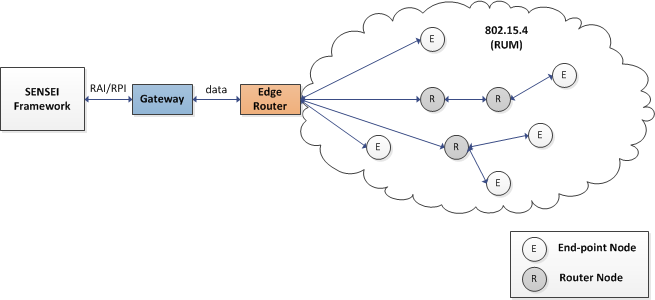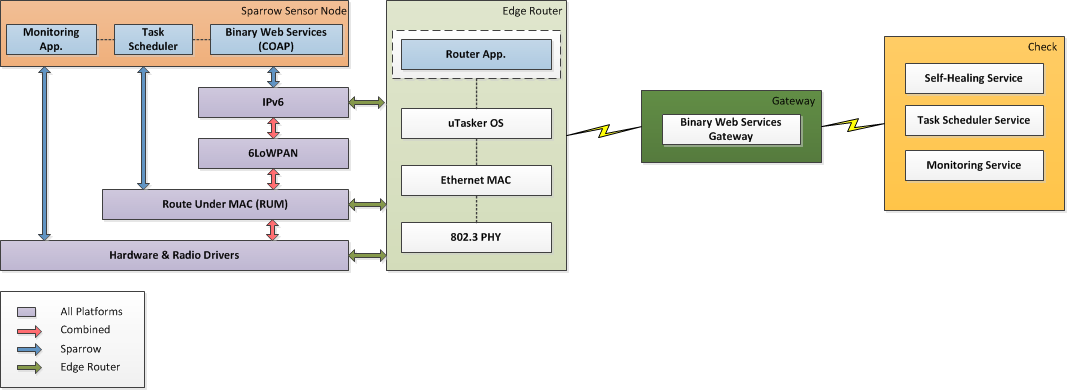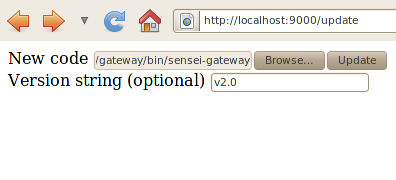| Version 26 (modified by , 14 years ago) (diff) |
|---|
Table of Contents
Introduction
Architectural Overview
The Check architecture consists of the following entities:
- WSN Island: Sensor nodes organize into a multi-hop wireless network with tree topology in which some nodes act as routers for the end node leaves.
- Edge Router: An embedded network coordinator. Acts as a sink to the sensor node data and routes the island network traffic to an IPv6 network.
- Gateway: Binary Web Services (COAP) running on a machine in the same network with the Edge Router.
- Check Services: Self-healing, Task Scheduling and Monitoring Framework.
Software Architecture
The entire Check WSN architecture is given in the diagram below. The sensor network itself is built around RZRAVEN and Sparrow nodes that form a heterogeneous multi-hop network using a modified version of Atmel's RUM protocol over which we ported the Binary Web Services application and our own task scheduling and monitoring apps.
The gateway is an embedded ARM7 board running a modified version of the uTasker OS. An IPv6 layer added over the existing OS allows the SAM7X platform to act as an IPv6 Edge Router in addition to an 802.15.4 PAN Coordinator. The PAN Coordinator performs the classical functions defined in section 5.3 of the IEEE 802.15.4-2006 specification. It will start and maintain a non-beaconing network. The edge router functionality will route IPv6 network traffic to the appropriate end and router nodes based on their specific IPv6 addresses. The SAM7X provides multiple interfaces for users to interact with the 802.15.4 wireless network. Among these are RS232, USB, telnet and simple direct web interface.
Monitoring and reprogramming
Reprogramming - Gateway Watchdog
The SENSEI Gateway Watchdog is a monitoring and control service for the SENSEI Gateway. It allows for remote starting, stoping and updating the gateway code and can report the version string and uptime of the currently running gateway binary.
Software Requirements
Installing the Gateway Watchdog requires the following software packages:
- Linux PC (Ubuntu)
- g++, make
- Sockets C++ library (Also included in lib/Sockets-2.3.7; make clean; make; make install)
- libxml2, libxml2-dev
- libssl, libssl-dev
Project Organization
The watchdog shares its code with the gateway implementation and can be found in the /gateway folder in the SVN.
- /bin executables
- /src Gateway and Watchdog Code
- /xml Location of resource descriptions
- /lib Sockets++ library
- /config Configuration files (unused)
- /log Log files (unused)
Compiling the Gateway Watchdog
Some packages are required to be installed prior to the compilation of the Gateway Watchdog. Please install the following packages from the Ubuntu repository if you did not do already so.
$ sudo apt-get install gcc g++ libssl-dev libxml2-dev
Sockets library also needs to be installed:
$ cd ./lib/Sockets-2.3.7 $ make clean $ make $ sudo make install
The top-level Makefile will build everything with the following, which places the executables in ./bin.
make
To clean everything do
make clean
Running the Gateway Watchdog
The watchdog must be run from the root of the project
./bin/watchdog
Available command line options are:
-p HTTPD port (default: 9000)
-s HTTPD hostname for inserting in resource desciption (default: localhost)
-d domain name inserted in resource description (default: example.com)
-w WSAN island name inserted in resource description (default: Example)
-f folder where the gateway binary can be found (default: ./)
-c gateway binary filename (default: sensei-gateway)
-cert ssl certificate filename, also enables https operation
-pass ssl certificate passphrase, necessary if the certificate file is encrypted
The SENSEI Gateway Watchdog server runs by default on port 9000. It exposes the following URIs:
- /start - a POST request starts the gateway if not already started
- /stop - a POST request stops the gateway
- /update - a POST request with a form that has a 'file' field named 'code' updates the gateway binary, a 'text' field named 'version' can also be sent as the version string for the newly uploaded binary, otherwise version string will be taken from the uploaded file
- /uptime - a GET request returns the uptime of the gateway in seconds or -1 if the gateway is not started
- /version - a GET request returns the gateway version string, if one is available.
For the /start, /stop and /uptime urls GET requests are also accepted. They return an HTML page that allows easy access to the operations from a browser.
Test demo
The Gateway Watchdog provides monitoring and control of the SENSEI Gateway. To run a demo, please start the Watchdog service by giving the following commands in a console:
$ make $ ./bin/watchdog -f bin/ -c sensei-gateway -d pub.ro -w test
This will start the Gateway Watchdog which runs an http server at localhost:9000. You will be able to see the registered gateway watchdog URIs by querying the Resource Directory at http://sensei-dev1.grid.pub.ro:8184/rd. A possible response from the Resource directory is shown below.
The watchdog service will now accept requests at the following URIs:
- Start Gateway http://localhost:9000/start
- Stop Gateway http://localhost:9000/stop
- Update Gateway code http://localhost:9000/update
- Gateway uptime http://localhost:9000/uptime
- Gateway version http://localhost:9000/version
As an example, by pointing your browser to the Start Gateway URI you should see following response
Clicking the Start button will start the gateway if it is not already started. You can check that the gateway is running by clicking the following link http://localhost:8000
By pointing your browser to the Stop Gateway URI you should see the following response
Clicking the Stop button will stop the gateway.
By pointing your browser to the Update Gateway code URI you will be able to upload a new binary to the gateway and, optionally, specify a version string for this binary, as shown bellow.
Note that to run the new gateway code you have to stop and then start the gateway.
Scheduling
The Scheduling algorithm is presented as a stand-alone application that gathers information about the network from a Resource Directory (types of nodes, topology).
Prerequisite: Prior to executing the scheduler the sub-tasks of the application have to be already programmed on the nodes, as stopped tasks.
./check-schedule <RD> <tdag> <tskmap>
Input files:
- tdag is a Task Dependency Acyclic Graph. It contains a graph of data dependencies between tasks and their associated bandwidth. The format is a textfile containing
- t, number of tasks
- d, number of dependencies
- a tuple (x,y,z) for each edge in the dependency graph on one line, with x,y being incident tasks and z being the bandwidth.
- tskmap is a task mapping file, associating each task in Task Dependency Acyclic Graph to the names of the tasks that have to be run on the network.
- tuples (x,s) are present on every line, x being the task index in the tdag file and s being the name of the task associated. Tasks are started based on their names
One run of the application is enough to calculate the best scheduling of the application over the network, the application will directly access the nodes and start the required tasks, provided the tasks are already present on the sensor nodes.
Self-healing
The Self-healing service in the Check framework overlays the self-healing capabilities provided by the stack running on the nodes. The latter continously ensures a correct topology of the island, while providing, through Sensei interfaces, topology information and individual node attributes.
In case a node fails to respond and a timeout message is received, then the Self-healing service chooses another node with the requested capability and automatically redirects the request to it.
Attachments (22)
-
rd.png (94.4 KB) - added by 14 years ago.
Resource Directory query example
-
start.png (8.3 KB) - added by 14 years ago.
Start gateway response
-
stop.png (8.3 KB) - added by 14 years ago.
Stop gateway response
-
update2.png (14.8 KB) - added by 14 years ago.
Update example
- arhi.png (22.1 KB) - added by 14 years ago.
- sensei+rum.png (34.8 KB) - added by 14 years ago.
- telnet.png (18.7 KB) - added by 14 years ago.
- Monitor_screen1.png (77.6 KB) - added by 14 years ago.
- Monitor_screen2.png (82.9 KB) - added by 14 years ago.
- Percentage_task-scheduling.png (30.8 KB) - added by 14 years ago.
- Runtime_task-scheduling.png (34.4 KB) - added by 14 years ago.
-
NetworkTable.png (33.7 KB) - added by 14 years ago.
RUM network table with multihop
-
sh-config.png (72.2 KB) - added by 14 years ago.
Self-healing: configuration file
-
sh-suspend service.png (27.5 KB) - added by 14 years ago.
Self-healing: suspend the temp service on a node
-
sh-no service.png (43.6 KB) - added by 14 years ago.
Self-healing: nodes are failing without the self-healing service
-
sh-service startup.png (22.4 KB) - added by 14 years ago.
Self-healing: at service startup it recognizes the resources being monitored
-
sh-start node.png (56.4 KB) - added by 14 years ago.
Self-healing: the service starts a node to assure service constraints
-
sh-multi island failing.png (85.9 KB) - added by 14 years ago.
Self-healing: without the help of self-healing, sensor readings lack values
-
sh-multi island new node.png (138.1 KB) - added by 14 years ago.
Self-healing: the temperature service is started on a node in a different island
-
sh-performance.png (249.1 KB) - added by 14 years ago.
Self-healing: timings
- Monitor_screen1.jpg (157.2 KB) - added by 14 years ago.
- Monitor_screen2.jpg (58.9 KB) - added by 14 years ago.
Download all attachments as: .zip






